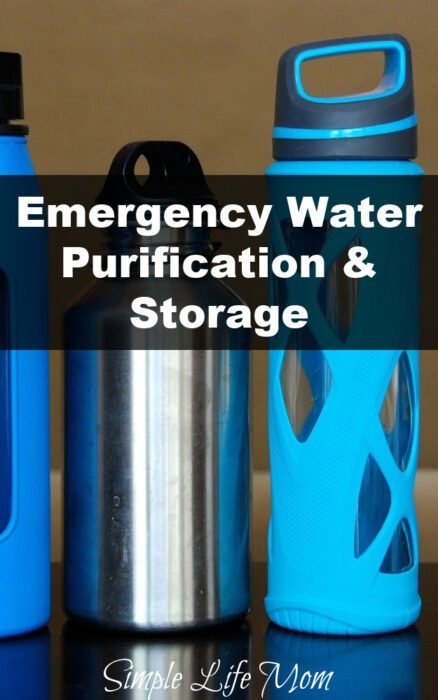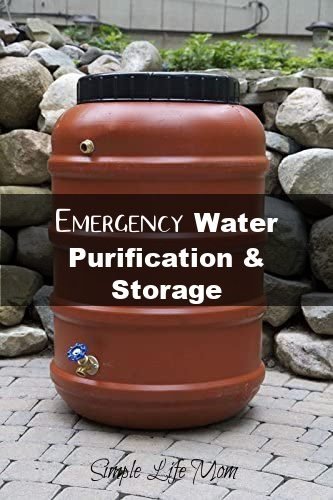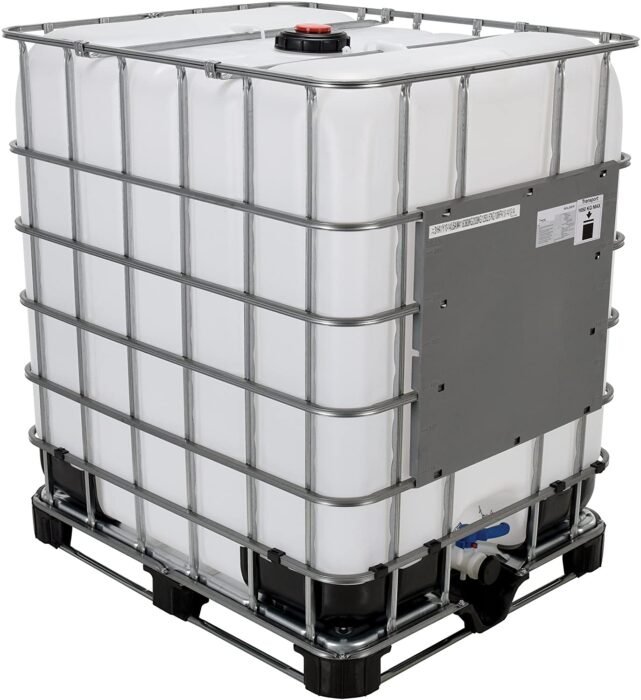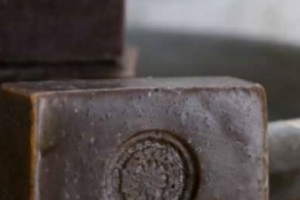Clean water is vital for survival. Without water, you can die after 3 days from dehydration. Contaminated water lists a whole new set of problems that can be deadly in an emergency situation, making water purification and storage vital.
For the Emergency Preparedness Part 3, I will be discussing emergency water supplies and emergency water preparedness. There are a number of approaches to this that can be taken, depending on your living location and resources.
For some of us, water supply is simple. I have 2 fresh water springs that run under my property and come out on one end. They flow fast enough year long that they are a viable source. We also have a large creek that is less than half a mile away. If needed, we could use both sources easily.
But not everyone has these wonderful resources. This is when creativity and water purification knowledge is needed.

Daily Water Needs
We need water for a lot more things than drinking, though in emergencies we can definitely minimize our use in some areas and focus on drinking.
We use water for drinking, cooking, bathing and brushing teeth, washing clothes, washing dishes, washing home items, flushing toilets, and watering plants.
When you know your water source will only be shut off for 24-48 hours (water breaks happen), drinking and flushing toilets becomes priority.
Some people would say toilets are not an issue, but when you have a large family it can be. Even if you tell everyone not to flush until absolutely necessary, being able to flush is important so that clogs do not occur.
Short Term Water Emergencies
For short term water loss (24-48 hours), it’s important to have fresh, clean water on hand. We keep 1 gallon per person for a 3 day supply, plus multiple gallons of water put into washed milk jugs for use in toilets.
We’ve had to use this resource multiple times. We’ve had water and electricity go off for a long enough time that we’ve gone as an entire family to a gas station to use the bathrooms and get warm.
Long Term Water Emergencies
But what happens when water and electricity is disrupted for a longer period of time? I will talk about electricity in a different part, but I will discuss what you could do to have water in a long term water emergency. There are 3 things to do now:
- Know Your Water Sources
- Know How to Purify Water
- Know How and Begin Water Storage
Water Sources
First, identify what types of water sources are around your home and workplace. Do not disregard your workplace in case you need to stay there for some reason in an emergency.
There are a lot of natural water sources available for people who are not in desserts or inner cities. Even there, there are water sources, but you need to know your stuff!
Natural and Man-made Water source ideas:
- Natural Springs
- Rivers and Streams
- Ponds
- Ocean or Other Salt Water
- Wells
- A Pool
- Rain Water and Snow Fall
- Purchased Water Bottles
- Other places around the home
- toilet tank
- fish tank
- water heater (there is a release valve toward the bottom)
Natural Springs
If you have a natural spring, you need to know where it comes from and what it goes through. Underground springs are generally clean from being filtered through soil, but I always advise to test your water source. Does the spring slow to a trickle at certain times of the year? If so then it’s more likely to be contaminated during those times. Springs should flow at a good rate to be depended on. Some sources say it should be 2 gallons per minute to be depended on for drinking water. Ours flow at about half of that, but we use ours for water for our animals and garden at times and will definitely use for our own water if needed.
Rivers, Streams, Ponds, Pools
Other natural fresh water sources like rivers, streams, and stagnant water like ponds and pools need to be treated with knowledge. After all, these water sources can be contaminates upstream by human activity, or be growing a nasty amount of bacteria that will cause you to lose more water by running to the bathroom than you could gain by drinking it; even if it looks crystal clear (See: water purification below).
Wells
If you have access to a well, then you will probably be aware of testing it on a regular basis and how to use it. We had one at our old house and it was a wonderful resource, but very strong in minerals making it interesting on the hair.
Salt Water Sources
Salt water sources must also be processed before use. Most understand after a visit to the beach that you cannot drink salt water! I thought I’d say that in case someone needs to hear it. But there are methods to converting it to drinkable water.
Rainwater
Rain collection is a wonderful method of water collection and storage. We paid my brother-in-law to make us a rain barrel when they were making one for themselves. It was great to have! We attached it to the gutter coming from our roof. From there we used the spout to water my garden. There was enough of a flow that I didn’t have to carry buckets, but could just lie the house down in the garden.
Purchased Water Jugs
You can also buy large water jugs. I have a number of these stored for emergency use. You’ll want quickly accessible water on hand so that you are settled for quick emergencies and are hydrated to go seek out your other sources if needed. I keep 3 gallon jugs per person for those 24-48 hour water shut offs.

Water Purification
Once you’ve found a good water source, how can you make it potable? You need to be able to store and purify.
Sometimes you will store first (rain barrel), and other times you will purify and then store. I will discuss both options.
Understand that water must be purified! Click here to learn more about what even your normal tap water contains: Do I Need to Filter My Water?
Boiling for Water Purification
Boiling water to purify it works! It does require a lot of fuel to bring the water up to boiling point and boil for long enough to purify. And if there are a number of people who need their water purified, then that’s a lot of fuel. Keep this in mind.
Boiling water will kill anything living within the water (bacterial contaminates). Water should be boiled for 1-3 minutes.
If there is a possibility that your water is contaminated with chemicals, know that boiling will not remove these chemicals. This goes for large particles or radiological contaminates. Most of us do not have to worry about chemicals or radiological contaminates. In an emergency, our water is not healthy to drink, but sources are mainly biologically contaminated and can be cleaned through boiling.
Some people recommend to add a pinch of salt to the pot after you boil it to restore flavor. It’s also good to keep your salt levels up when you’re in an emergency situation.
Purchased Water Purification Systems
We have a 2 gallon Berkey Water Filter. I love it. I only drink from it. If I do get water directly from the faucet, I’m shocked at how strong the chemicals smell!
I also like that it’s not a home filtration system so that whenever we need it for emergencies it’s a stand alone item. Ours sits right by our kitchen sink, so it’s really easy to use our pull away faucet to fill it up.
There are a number of home or on the go filtration systems or devices that you can purchase. I like to know that we have some on hand in case of an emergency. Here are a few to keep in mind:
On-The-Go Water Purification
Homemade Water Filtration System
I mention other methods of homemade water purification below, but there is a filtration system that you can make now to have in an emergency if you’d rather not purchase one of the above options.
We made a charcoal water filter for a school project once. It was easy to do and can be adapted for a more sturdy system. I’ll give you the basics of what we did:
- Cut the bottom off of a clean 2 liter plastic bottle. Poke a small hole in the cap and screw it on tightly.
- Turn the bottle upside down and pack a small piece of cloth into the bottle beside the cap. If you don’t have cloth, you can use grass packed tightly.
- Fill the bottle halfway with charcoal powder.
- Carefully place enough sand on top of the charcoal to leave 1/4 of the bottle empty at the top (1/2 charcoal, 1/4 sand, 1/4 air).
- Place the upside down bottle (cap first) into a large jar (We used a quart mason jar).
Slowly pour water onto the sand. Don’t pour too fast or it will overflow. If the water is clear then it’s ready to drink. Micro-organisms can still pass through this type of filter so it’s often recommended to boil after filtering.
Other Emergency Options
Chlorine
This is not a favorite method of mine, but in an emergency, it’s good to know.
Bleach should be pure, without any scents or other additives.
To purify, check the ingredients, and do the following:
If it is 6% sodium hypochlorite:
- add 8 drops to 1 gallon of water.
- Set aside in an open container for 30 minutes
- Repeat drops
- Let sit for 30 more minutes
- Drink
If it is 8.25% sodium hypochlorite:
- add 6 drops to 1 gallon of water
- Set aside in an open container for 30 minutes
- Repeat drops
- Let sit for 30 more minutes
- Drink
Remember that bleach degrades by 20% each year so the potency will not be as strong even after one year. I found this out doing chemistry projects with teens over the years. So purchase fresh bleach to keep on hand each year.
Using a Pool for an Emergency Water Source
A pool may be your only water source, depending on where you live. If they are overwintered, they will probably have chlorine overwinter chemicals. If they are blue and taken care of, they will also be full of chemicals. As I said above, boiling water doesn’t remove chemicals, so what do you do?
Well, use it to flush toilets before using as drinking water. But if you must use pool water, just make sure to use a carbon filter.
Carbon filters (like Berkeys or the homemade filter above) filter out chemical and bacterial contaminates. There are a variety of carbon filters that you can purchase before an emergency (See above).
Water Purification with Sunlight
You can purify water using sunlight. You will need a clear plastic bottle that is no bigger than 2 liters. Do not use a glass bottle, because glass blocks a lot of UV rays.
It will need to sit in blazing sunlight for at least 6 hours, over a reflective surface is best (like a white sheet, paper, or metal). Continual sunlight will kill most bacteria, viruses, and other organic contaminates. Leave up to 2 -3 days if the water was questionable, shaking occasionally to add oxygen to the water and increase bacterial death rate.
This is a method that I would use if I already thought the water was pretty safe (running creek water), but I wanted to make sure.
Water Storage
Water can be stored in all kinds of sizes. You can keep 1-5 gallon jugs for ease of sue and transportation, and/or you can purchase a large home container. These large containers can hold anywhere from 100 to 2000 gallons!
The larger containers are not always ready to use, but it is easy to add purifiers to the entire container at once. You cannot travel with them, but they make great sources for those who are in a city setting without many options.
We have natural springs so we do not have large containers of water, but we do have gallon jugs ready to drink for 3 days for each member in my family.
Types of Storage Containers:
- Small bottles and jugs
- Large water storage containers
- Rain Barrels
I advise to keep a variety of water sources on hand in case you need to move or one becomes ruined.
Containers should be durable plastic (Type 2 or high density polyurethane). Milk jugs break down and should just be used for toilet tank water for flushing.
Where to Store Water
Store water in a cool, dark location. This will slow growth of any organisms and stop plastic breakdown.
No light and cool location means your water can be stored indefinitely after it is purified! I know that’s a big question answered for many of you.
Winter Water Storage
You want your emergency water supply to be available, even in the winter. If you store water outside, it can freeze and not only be inaccessible, but also break the container you have it in because of frozen water expansion. Keep these things in mind when you choose a container and where you put it. Inside a garage or basement is often good enough to keep it from freezing, but consider where the water would go if the container breaks.
Final Thoughts
Even though I’ve given ideas for water purification, remember what I’ve said many times – I am not a doctor or professional water purifier. I’m just someone trying to share what I’ve learned over the years. Never drink water from a questionable source. Always consult a professional about water purification first.
Learn more with the other Emergency Preparedness Articles:
- Emergency Preparedness Part 1: Types of Preparedness
- Emergency Preparedness Part 2: Emergency Food Supply







1 Comment
Leave your reply.